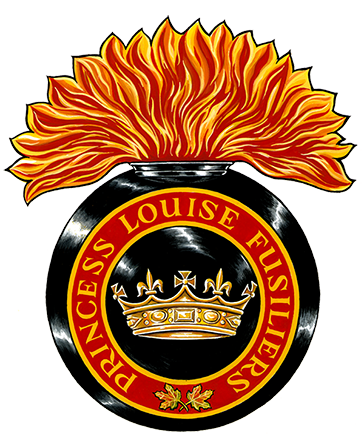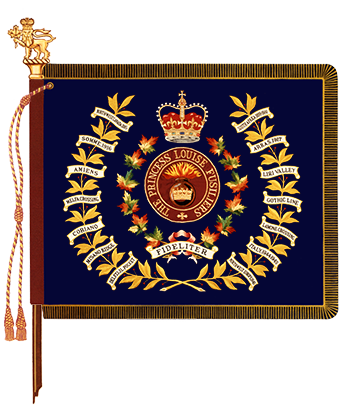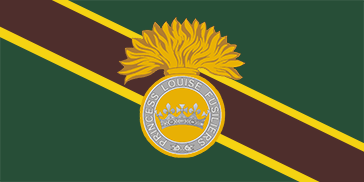The Princess Louise Fusiliers
The official lineage of The Princess Louise Fusiliers infantry regiment.

Badge
Description
A grenade Sable issuant therefrom a flame of nineteen points proper charged with the coronet of a daughter of the Sovereign Or encircled by an annulus Gules edged, charged in base with two maple leaves and inscribed PRINCESS LOUISE FUSILIERS in letters Or.
Symbolism
The coronet of H.R.H. The Princess Louise refers to the regiment's name. The grenade alludes to the original role of fusiliers, who were soldiers specially equipped to escort artillery trains. The red and white of the flames are the livery colours of the regiment and the official colours of Canada. "PRINCESS LOUISE FUSILIERS" is a form of the regimental title, and the maple leaves represent service to Canada.
Motto
FIDELITER (Faithfully)
March
"British Grenadiers"
Alliance
British Army
The Royal Irish Regiment
Regimental colour

Camp flag

Battle honours
North West Rebellion
NORTH WEST CANADA, 1885.
South African War
SOUTH AFRICA, 1899-1900.
The First World War
SOMME, 1916; ARRAS, 1917; HILL 70; YPRES, 1917; AMIENS.
The Second World War
LIRI VALLEY; Melfa Crossing; GOTHIC LINE; CORIANO; LAMONE CROSSING; Misano Ridge; ITALY, 1944-1945; Arnhem, 1945; Delfzijl Pocket; NORTH-WEST EUROPE, 1945.
South-West Asia
AFGHANISTAN
Lineage
This Reserve Force regiment originated on 18 June 1869 and incorporates the following regiment and machine gun battalion.
The Princess Louise Fusiliers originated in Halifax, Nova Scotia on 18 June 1869, when 'The Halifax Volunteer Battalion of Infantry' was authorized to be formed.Footnote 1 It was redesignated: '66th The Halifax Volunteer Battalion of Infantry' on 5 November 1869;Footnote 2 '66th Battalion, "Princess Louise Fusiliers"' on 14 November 1879;Footnote 3 '66th Regiment "Princess Louise Fusiliers"' on 8 May 1900;Footnote 4 and 'The Princess Louise Fusiliers' on 15 May 1920.Footnote 5 On 1 December 1936, it was amalgamated with the 'Headquarters' and 'A' Company' of the '6th Machine Gun Battalion, CMGC' (see below) and redesignated 'The Princess Louise Fusiliers (Machine Gun)'.Footnote 6 It was redesignated: '2nd (Reserve) Battalion, The Princess Louise Fusiliers (Machine Gun)' on 1 January 1941;Footnote 7 'The Princess Louise Fusiliers (Machine Gun)' on 15 February 1946;Footnote 8 'The Princess Louise Fusiliers' on 11 April 1958;Footnote 9 'The Princess Louise's Fusiliers' on 14 May 1985;Footnote 10 and 'The Princess Louise Fusiliers' on 5 January 2009.Footnote 11
Notes:
Upon redesignation as The Princess Louise Fusiliers on 15 May 1920 (see above), it was organized as a two battalion regiment with the 1st Battalion (64th Battalion, CEF) on the Non Permanent Active Militia order of battle and the 2nd Battalion (no CEF designation) on the Reserve order of battle. The reserve unit was disbanded on 14 December 1936 (GO 3/37).
The Princess Louise Fusiliers were disbanded for the purpose of reorganization on 15 September 1920 and reorganized the same day (GO 232/20). This change was administrative and does not affect the lineage of the regiment.
The Princess Louise Fusiliers were disbanded for the purpose of amalgamation on 30 November 1936 and reorganized the next day (GO 180/36). This change was administrative and does not affect the lineage of the regiment.
On 22 December 1964, The Princess Louise Fusiliers and The Halifax Rifles (RCAC) were ordered to effect an amalgamation as an infantry battalion under a "to be determined" designation by 31 March 1965 (SD 1 Letter No. 64/68). This amalgamation was cancelled through Amendment 1 to SD Letter No. 64/68 (EASCOM Msg G 5631 of 22 Sep 65).
The '6th Machine Gun Battalion, CMGC' originated in Halifax, Nova Scotia on 1 June 1919, when the '6th Machine Gun Brigade, CMGC' was authorized to be formed.Footnote 12 It was redesignated the '6th Machine Gun Battalion, CMGC' on 15 September 1924.Footnote 13 On 1 December 1936, it was amalgamated with 'The Princess Louise Fusiliers', as above.
Notes:
The 6th Machine Gun Brigade, CMGC was authorized a Reserve order of battle counterpart on 1 June 1919 (GO 104/20). The reserve unit was disbanded on 14 December 1936 (GO 3/37).
The 6th Machine Gun Battalion, CMGC was disbanded for the purpose of amalgamation on 30 November 1936 and reorganized the next day (GO 180/36). This change was administrative and does not affect the lineage of the regiment.
On 1 December 1936, 'The King's Canadian Hussars', now the '88th Field Battery, RCA' transferred to the Supplementary Order of Battle, amalgamated with '"B" Company, 6th Machine Gun Battalion, CMGC' and '"C" Company, 6th Machine Gun Battalion, CMGC' was amalgamated with 'The North Nova Scotia Highlanders', now 'The Nova Scotia Highlanders' (GO 180/36). The perpetuation of the 6th Machine Gun Battalion, CMGC (1919-1936) was assigned to The Princess Louise Fusiliers (Machine Gun) (GO 76/37).
Perpetuations
'64th "Overseas" Battalion, CEF'
Headquarters Location
Halifax, Nova Scotia
Operational history
North West Rebellion
The 66th Battalion, "Princess Louise Fusiliers" mobilized three companies for active service on 10 April 1885.Footnote 14 The companies served with the 'Halifax Provisional Battalion' in the Alberta Column of the North-West Field Force.Footnote 15 The companies were removed from active service on 24 July 1885.Footnote 16
South African War
The 66th Battalion, "Princess Louise Fusiliers" contributed volunteers for the Canadian Contingents during the South African War.Footnote 17
The First World War
The 66th Regiment "Princess Louise Fusiliers" was placed on active service on 6 August 1914 for local protection duties.Footnote 18
The 64th Battalion, which was authorized on 20 April 1915 as the '64th "Overseas" Battalion, CEF',Footnote 19 embarked for Great Britain on 31 March 1916.Footnote 20 The battalion provided reinforcements to the Canadian Corps in the field until 7 July 1916 when it ceased to function.Footnote 21 On 7 December 1916, it was reorganized,Footnote 22 and on 8 January 1917 it absorbed the '37th Overage Battalion, CEF'.Footnote 23 The battalion was disbanded on 27 July 1917.Footnote 24
The Second World War
Details from the regiment were called out on service on 26 August 1939 and then placed on active service on 1 September 1939, under the designation 'The Princess Louise Fusiliers (Machine Gun), CASF (Details)', for local protection duties.Footnote 25 The details called out on active service were disbanded on 31 December 1940.Footnote 26
The regiment subsequently mobilized the '1st Battalion, The Princess Louise Fusiliers (Machine Gun), CASF' for active service on 1 January 1941.Footnote 27 It was redesignated: 'The Princess Louise Fusiliers (Motor), CASF' on 26 January 1942;Footnote 28 '1st Battalion, The Princess Louise Fusiliers, CIC, CASF' on 31 January 1943;Footnote 29 '11th Infantry Brigade Support Group (The Princess Louise Fusiliers), CIC, CASF' on 12 August 1943;Footnote 30 and '11th Independent Machine Gun Company (The Princess Louise Fusiliers), CASF' on 1 July 1944.Footnote 31 The battalion embarked for Great Britain on 26 October 1942.Footnote 32 The machine gun company landed in Italy on 10 November 1943, as part of the 11th Infantry Brigade, 5th Canadian Armoured Division.Footnote 33 On 13 July 1944, the '12th Independent Machine Gun Company (The Princess Louise Fusiliers), CIC, CASF' was organized in Italy to serve with the newly formed 12th Infantry Brigade, 5th Canadian Armoured Division.Footnote 34 In February 1945, both companies moved with the 1st Canadian Corps to North-West Europe,Footnote 35 where the 12th Independent Machine Gun Company was disbanded on 15 March 1945, and the 11th Independent Machine Gun Company fought until the end of the war.Footnote 36 The overseas company was disbanded on 15 February 1946.Footnote 37
South-West Asia
From 2002 to 2014, the Princess Louise Fusiliers reinforced various CAF units deployed to Afghanistan.Footnote 38
Page details
- Date modified: